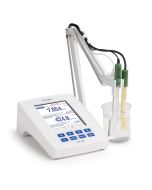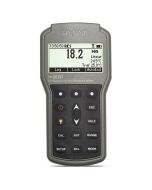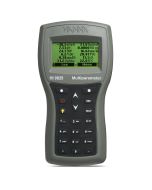Resistivity

Resistivity is a measurement in which electrical charges on particles in a medium are moved under the influence of a potential difference. Resistivity is a measure of concentration, not for a specific ion type. An ion is a charged particle present in the solution that contributes to the current flow. Ions are formed when a salt such as sodium chloride is dissolved in water to form electrically charged particles. A simplified example is sodium chloride that separates into Na+ and Cl-. However, the measurement is affected by many things such as the type of ionic compound(s) dissolved in the water, the ions’ mobility, the solution viscosity, temperature, and concentration.
Resistivity uses units of Ohms/cm (Ω•cm, KΩ•cm, MΩ•cm). For example, ultrapure water is said to have a resistivity of 18.2 MΩ•cm at 25oC.
Resistivity and conductivity are reciprocal units that may be easily converted. The practice is to use resistivity readings for very low electrolyte concentrations or trace contaminants (i.e. ultrapure water). Electrode style and measurement techniques also contribute to making resistivity or resistivity measurements reliably.
High purity water used in power generation, semiconductor manufacturing, and other industries can be difficult to measure due to the ability of carbon dioxide (CO2) from the air to diffuse into water and form carbonic acid (H2CO3). Carbonic acid quickly dissociates into hydrogen ions (H+) and bicarbonate ions (HCO2-). These ions will increase the conductivity and decrease the resistivity of the water. In order to measure high purity water accurately it is necessary to perform a continuous flow measurement. A platinum, four-ring probe with a threaded connection and a stainless steel body flow cell are used for low flow sampling. The flow cell allows for a connection to a water source to more accurately determine the conductivity or resistivity without exposure to air. A resistivity meter is ideal for monitoring the efficiency of a mixed bed resin or equivalent system that produces high purity water of 18.2 MΩ•cm at 25oC.
Benchtop Meters
Benchtop meters are available with probes that use the four-ring technology. The benchtop meters have automatic calibration and automatic range selection. Benchtops also have the USP <645> method including a multiparameter pH/EC version that is useful for all three stages of verification.
Portable Meters
Portable meters are available with probes that use either the two pin (amperometric) or four-ring (potentiometric) technology. The portable meters include those with manual selection of ranges and versions with automatic range selection. Meters are available as single parameter or multiparameter versions. Single parameter portables with the USP <645> method pre-programmed are also available along with a low flow cell to prevent carbon dioxide from entering into the sample.
Process Meters
Process controllers are available for continuous monitoring and display results in real time. Process controllers have the ability to use a relay to activate a solenoid valve or other device to make adjustments to a process. This is useful for many applications including the switching of DI mixed beds to maintain high purity of water.
Accessories
Accessories include shockproof rubber boots used with portable meters to offer additional protection against accidental drops of the meter. The shockproof rubber boots increase the tactile feel of the meter, giving it a non-slip grip. Other accessories included replacement items supplied with some of the multiparameter meters.










